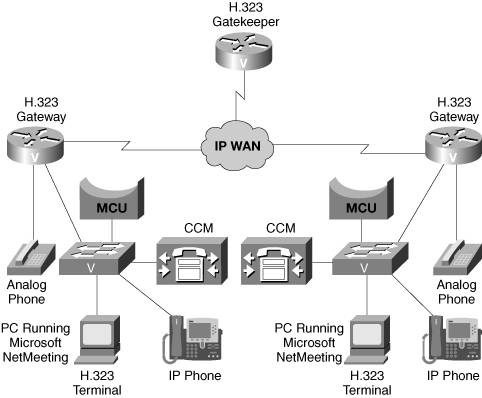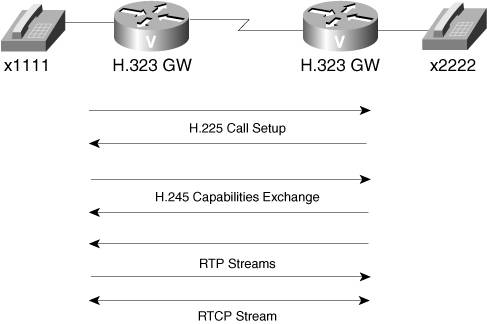The Tried and True Language: H.323
| H.323 represents the most mature of the three protocols considered in this chapter. However, the H.323 gateway protocol actually embodies multiple protocols. So, when you consider H.323, think of it as a collection of protocols, rather than a single protocol. For example, H.323 includes protocols to set up and tear down VoIP calls, protocols to encode video transmissions, protocols to encode voice conversations, and even a data collaboration protocol for shared white boarding. But for now, let's focus on just a couple of the H.323 protocols (used for VoIP calls), specifically:
H.323 Pieces and PartsIn addition to the protocols that fall under the H.323 umbrella, H.323 also defines various hardware components, as shown in Figure 5-3. Figure 5-3. H.323 Components The following sections cover these components. TerminalsAn H.323 terminal acts as an endpoint in a conversation and communicates with another H.323 terminal. Notice that the Cisco IP phones are not considered terminals because these IP phones lack the full set of H.323 features. A PC running Microsoft NetMeeting does, however, act as an H.323 terminal. GatewaysYou can train your Cisco router to act as an H.323 gateway (using the appropriate Cisco Internetwork Opertaing System [IOS] software). An H.323 gateway translates back and forth between different types of audio formats (for example, VoIP and digital voice traveling over a T1 circuit). GatekeepersToo many VoIP calls flowing over the WAN can oversubscribe (that is, require more bandwidth than is available) the WAN. To prevent WAN oversubscription, an H.323 gatekeeper can serve as a "traffic cop" for the IP WAN, keeping track of the available bandwidth. Before a call can travel across the IP WAN, an H.323 gateway or a CCM server can request permission from the H.323 gatekeeper. If WAN bandwidth is available for the call, the gatekeeper grants the connection request. However, if the WAN lacks sufficient bandwidth to support the call, along with all of the other existing calls, the gatekeeper can deny the connection request, thereby protecting the original voice calls from a bandwidth oversubscription that would be caused by an additional call. Multipoint Control UnitTechnically, a conference call is a multipoint call, meaning that multiple endpoints participate in the same call. An H.323 multipoint control unit (MCU) handles the signaling to add and remove participants from a conference call, and the MCU also mixes multiple audio and/or video streams together. The process of mixing audio and video streams requires processing power. Therefore, VoIP network designers often use dedicated hardware (for example, digital signal processors located in Cisco routers or switches) to act as conferencing resources. H.323 Call TypesThe previously mentioned gatekeepers are optional components because H.323 gateways can communicate directly between themselves. However, direct gateway-to-gateway calls suffer from scalability limitations. If you introduce gatekeepers into the network, the gateways communicate with gatekeepers using the RAS channel. Larger topologies might contain multiple gatekeepers, and those gatekeepers also communicate with each other using the RAS channel. Consider the following examples of how calls are completed in the following H.323 networks:
H.323 Gateway-to-Gateway CallsDirect gateway-to-gateway calls don't require a gatekeeper. Specifically, both gateways communicate directly with each other, as shown in Figure 5-4. First, H.225 performs the call setup, followed by H.245 performing a capabilities exchange. However, this H.225 and H.245 negotiation requires numerous packet exchanges between the gateways. Another, more efficient, option is H.323 Fast Connect, which performs the call setup and does a capabilities exchange in a single exchange of messages between the two gateways. Figure 5-4. H.323 Call Setup without a GateKeeper note
H.323 Calls Using a GatekeeperIn H.323 topologies containing a gatekeeper, the originating gateway (for example, a Cisco voice-enabled router) requests permission to place a call from the gatekeeper, using an admission request (ARQ) message, after which the gatekeeper might send an admission confirm (ACF) or an admission reject (ARJ) message. If the gatekeeper grants permission for the originating gateway to place the call, the call setup proceeds. The destination gateway also sends an ARQ to the gatekeeper. If permission for the destination gateway to set up the call is granted, the call setup proceeds as usual, using H.225 and H.245, after which RTP streams audio directly between the gateways. This call setup sequence is illustrated by the numbered steps in Figure 5-5. Figure 5-5. H.323 Call Setup with a Gatekeeper For even larger environments, you can have multiple gatekeepers involved in the call setup. The main difference with such a configuration is that when the first gatekeeper gets an admission request, that gatekeeper sends a location request (LRQ) and must receive a location confirm (LCF) from the remote gatekeeper before sending an ACF to the originating gateway. To increase the availability of H.323 networks, you can configure multiple gatekeepers and/or gateways to service the same phone numbers. High availability technologies such as Hot Standby Router Protocol (HSRP), where one router backs up another router, can also help maintain uptime in your H.323 network. Cisco also offers a more scalable redundancy solution called clustering. With clustering, multiple gatekeepers belong to a group of gatekeepers called a cluster. When a gateway registers, the gateway is notified of a primary gatekeeper within the cluster to use, in addition to an alternate gatekeeper, which the gateway can use if the primary gatekeeper is unavailable. |
EAN: 2147483647
Pages: 138



